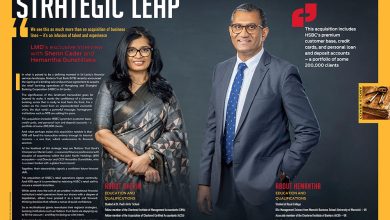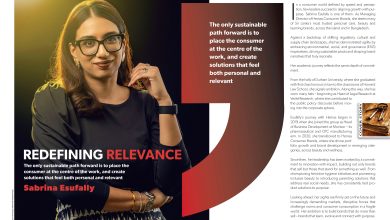COVER STORY

LMD EXCLUSIVE
It’s All About Alignment
Dumith Fernando calls for an alignment of funding rules, a skills strategy and incentives to boost capital markets in the post-COVID investment landscape
An experienced hand in the financial services industry both in Sri Lanka and overseas, Dumith Fernando took over the reins as Chairman of the Board of Directors of the Colombo Stock Exchange (CSE) with effect from 1 July, having served on the board of the CSE since 2017.
Fernando is also the Chairman of investment banking firm Asia Securities Holdings, which he has led for the last six years. He also serves as an Independent Director of Union Assurance and Singer (Sri Lanka), in addition to being a member of the Financial Stability Consultative Committee of the Central Bank of Sri Lanka.
The CSE’s Chairman boasts over two decades of experience in international and Sri Lankan capital markets, having spent much of his career in the international financial centres of New York and Hong Kong with global banking giants such as JPMorgan Chase and Credit Suisse.
Until his return to Sri Lanka in 2013, Fernando was Managing Director and Group Chief Operating Officer of Credit Suisse Asia Pacific, and a member of the firm’s Global Leadership Council.
In this exclusive interview with LMD, he discusses current developments, the state of the nation and plans for the capital market. And despite the numerous unforeseen market risks that have transpired in recent times, he conveys a note of cautious optimism vis-à-vis the future investment landscape in Sri Lanka.
– LMD
Q: How is the bourse faring in the context of regional and global trends?
A: It has been a strange year for capital markets around the world. What we have seen in capital markets globally has been unprecedented even compared to the global financial crisis (GFC). The amount of liquidity pumped in by central banks is multiples of what happened over a number of years after the GFC.
Many markets especially the US were coming off a strong 2019 and company earnings around the world were performing reasonably well. But indices that measure investor fear were at historical highs in February. So although markets got off to a reasonably good start, post March, they took a beating.
To put this in context, the All Share Price Index (ASPI) was down 13 percent year to date in end-August. Since 20 March however, which is when we closed our market for a couple of months, the index has risen by 17 percent.
Looking at some of the smaller emerging markets in Asia or frontier markets, Vietnam was down 12 percent year to date and up four percent from 20 March; the Philippines was down 23 percent year to date, up seven percent from 20 March; Indonesia was down 17 percent year to date and Thailand was down 15 percent year to date. So that’s how the regional frontier and small emerging markets performed.
In terms of large markets in Asia, Japan was down about 2.3 percent year to date, Hong Kong was 10 percent lower and Singapore was down 20 percent. The US was up four percent at the same time and about 46 percent from 20 March.
Certain larger markets have been resilient and fared relatively well. Markets that had COVID-19 under control such as South Korea have been up substantially since March.
As for how the Sri Lankan market fared in the context of regional and global trends, it has been in the middle of the pack. Not one of the leaders nor one of the worst, which is quite impressive given that ours is a small market with limited liquidity.
In the wake of COVID-19, many foreign investors have exited in a major way. But ours was already an attractively valued market and one of the cheapest. It wasn’t Sri Lanka specific as investors began exiting all frontier and emerging markets. Maybe the fact that our market was closed for two months made them somewhat more disheartened.
At the time of this interview in late August, there’s been approximately Rs. 25 billion worth of net foreign sales since we opened the market in May compared to about 5.5 billion in net sales before that and about 26 billion year to date.
What happened after May was that valuations looked so good – there was greater confidence locally that the coronavirus situation was under control and local buying started streaming in. Interest rates were also cut to combat the COVID-19 crisis. In addition, more confidence was building up on a possible strong government returning following the general election in August.
All of this made it much more attractive for local investors. That’s why the market has been up since it reopened and then since mid-March.
There’s positive sentiment among local investors and if there continues to be a low interest rate and more effective policy-making environment, we expect that local interest will persist as stock market valuations are still extremely attractive.
Q: Where do you see the local bourse heading in the medium term – and what more must be done to revive it going forward?
A: There are three aspects we need to watch out for in the medium term.
Currently, business and investor sentiment is positive particularly following the general election. If that remains the case and there’s no recurrence of the COVID-19 situation, the playing field is set for us to do what is needed to achieve medium-term growth.
At the CSE, we want to do two things. One, is to better define the purpose of this exchange and that is important. Most people understand the stock exchange only as a place to trade stocks whereas it has a much broader role in the financial system.
The stock exchange’s first purpose is to revitalise long-term capital formation and promote better financial risk management. Its second objective is to deliver broader wealth generation opportunities for citizens. And the third objective is to establish a trusted venue for trading and the depository business.
One of the reasons the capital market and stock exchange have not been as relevant in the past to a broader economic and financial system is that the purpose and what we can do has been misunderstood as being very limited in scope.
The second thing we want to do is to identify the (five) strategic focus areas of the board in the medium term.
The first focus area is rerating the valuations of the stock exchange. We are and continue to be the lowest rated stock exchange from a valuation perspective and thus be extremely attractive. Our trailing price to earnings (PE) multiple on shares average 11.3 and the price to book value (PBV) is 0.8. Looking at a peer group of regional markets, their PE ratio is anywhere from 15 to over 20 – India is at 27; the price to net asset value or PBV ratio is anywhere between 1.5 and 2.
The second strategic focus area is attracting new listings to this market to substantially increase liquidity and investment options. This not only refers to listing state owned enterprises but there are numerous privately owned unlisted companies that are playing a major role in the economy whether it’s exporters or IT companies.
Several Board of Investment (BOI) companies have received substantial benefits and launched large business projects but aren’t listed. We’re working with government agencies like the Export Development Board (EDB), the Information and Communication Technology Agency (ICTA) and BOI to understand why entities under their purview are not listing.
We’re hoping that we can work with these agencies to build in incentive mechanisms to prompt some of these companies to enter the listing environment.
To increase liquidity, we have also liberalised the listing rules to bring new classes of listed companies into the mix.
The third strategic thrust is to promote growth in the active retail investor base. There are a large number of investor accounts at the CDS but very few have been trading. Some major impediments are lack of knowledge and awareness of the stock market and investing in general, lack of access and issues about whether it’s a safe place to invest.
We are developing an extensive programme along with the SEC to enhance financial literacy across the country. We are also working on digitising client onboarding and distribution so that investor access improves significantly.
At the same time there is evidence that how people operate in the market has improved and become more ethical, thereby alleviating some of the concerns around the safety of the stock market. Investor complaints that have come to CSE have dropped 70 percent in the last five years and the absolute numbers are also much smaller. Moreover, the number of referrals that the CSE surveillance team has sent to the Securities and Exchange Commission (SEC) on market activities has also dropped by about 70 percent.
Especially as foreigners exit, we need a strong local investor base and these initiatives are expected to help with that.
The fourth thrust is to improve the trust across our key stakeholders – i.e. issuers, investors and the general public. There are different agenda items around that, which are outward looking and stakeholder driven.
The final aspect is internally driven. Our goal is to re-establish operating profitability for the CSE or a path to that and consistent profitability for our members, which is the stockbroker firms, within the next three years.
This is an important strategic focus area because of the way we will get there. It is not merely a cost cutting exercise; what we have here is not a cost problem.
At the CSE, what we have is like a ‘supermarket’ with many empty shelves; we have a full exchange but have only filled a couple of shelves with one or two products – debentures and shares. But since we have the full supermarket, which is our entire stock exchange and depository infrastructure, there are so many other products that can be put on different shelves.
New product development – and therefore, revenue generation – is where our focus lies. Operating profitability is not just about cost reduction. We have started putting our thinking caps on regarding new product development. And generating consistent profita












